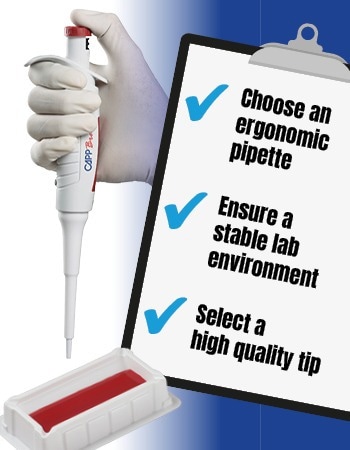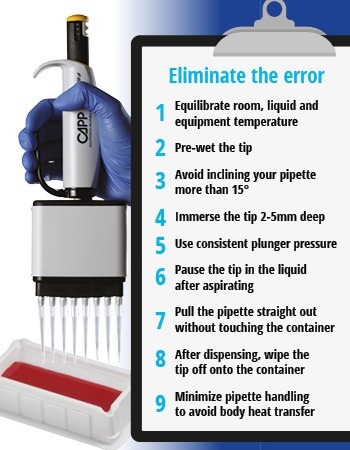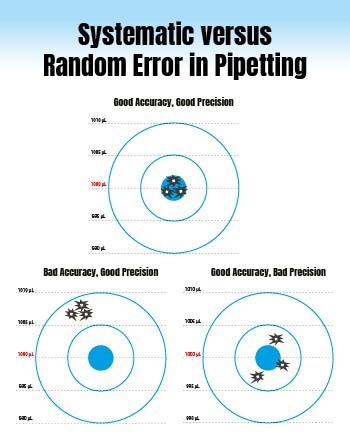With the usage of micropipettes in the life science laboratory, various pipette and pipetting errors have been linked. Users familiar with such micropipette issues can assist users to reduce further errors.
This article will help researchers, technicians, and students learn pipette errors and allow them to diagnose them rapidly. The main goal is to fulfill a few of the most frequently asked topics related to pipetting errors, such as “what is the difference between systematic vs. random error?” and “what are the sources of error in pipetting?”, among others.
CAPP manufactures premium-quality pipettes to reduce micropipette errors.
Improving the pipetting technique
Several pipetting errors can be traced to poor pipetting methods. When users work on their pipette handling skills, pipetting errors decrease considerably.
One rapid method of setting yourself up for a good pipette is choosing an ergonomic pipette, such as the CAPP ecopipette. Utilizing an ergonomic pipette helps decrease distress and primes users for successful pipetting.
CAPP suggests a stable laboratory setting to decrease the chances of random error. Quality needs to be kept in mind when choosing pipette tips. Relying on high-quality pipette tips will help users to decrease pipetting errors and enhance their pipetting technique more quickly. It is also beneficial to learn to identify the various kinds of pipettes and select the best pipette for the job.

Image Credit: AHN Biotechnologie GmbH
Finding an accurate technique to eliminate errors in pipetting
One of the most efficient methods of removing pipetting errors is finding a suitable method. By learning good pipetting techniques, researchers and laboratory technicians can learn to identify sources of error in pipetting, resulting in better results for their diagnostic assays and research work.
In this article, a few common sources of pipetting errors are explored, and suggestions are offered for enhancing users’ pipetting techniques.
As in the case of any new skill, it is strongly recommended to practice with a reliable pipette. Users will then be able to map theory to practice and decrease pipette error while enhancing both the precision and accuracy of their measurements.

Image Credit: AHN Biotechnologie GmbH
Common pipette handling errors
There are numerous pipetting errors that several scientists are not yet aware of, which can be corrected with the correct pipette method.
The first of such pipetting errors is pipetting too soon, as this may lead to systematic error. Employing calm and steady pressure on the plunger helps sustain the flow of liquid via the tip, decreasing the chances of pipetting error.
Holding the pipette at an angle is another additional pipetting error common in laboratories that decreases the effective hydrostatic pressure applied to the sample volume.
The perfect solution for users to tackle pipetting errors is by handling their pipette in a vertical position. One more common pipetting error is failing to pre-wet pipette tips.
Pre-wetting pipette tips enables the air cushion to balance to the liquid volume being aspirated. For this pipetting error to be avoided, inserting the tip not too deeply into the liquid has been suggested, and holding it there for ≈3 seconds before aspirating. To achieve even better outcomes, it is recommended to use premium quality pipette tips developed to decrease pipetting errors.

Image Credit: AHN Biotechnologie GmbH
Systematic error vs random error in pipetting
Two types of pipette errors cited in quality standards can impact piston pipettes. Recognizing the variation between both kinds of pipette error might help users keep their measurements truly precise.
Generally, the first pipette error is referred to as a systematic error. Systematic error cites a constant variation between the volume chosen by the user (nominal volume) and the volume they dispense.
To identify a systematic error in a piston pipette, the ISO standard ISO 8655-1:2002(en) suggests using an average of 10 measurements.
The second pipette error, random error, is known as a statistical measure that outlines the possible fluctuation in pipetted values due to chance events that might not be replicable every time.
These include fluctuations in the pipetting environment, minor variations in the pipette, or inconsistencies in how the user has read the volume. To identify the random error, the average of 10 repeat measurements of the liquid has been evaluated, and the scatter of these measurements is identified.
The bigger the systematic error or random error, the less precise a user's pipette will be.

Image Credit: AHN Biotechnologie GmbH
New Capp Bravo single channel pipette
Video Credit: AHN Biotechnologie GmbH
About AHN Biotechnologie GmbH
AHN Biotechnologie GmbH, based in Nordhausen, Germany, is a manufacturer of plastic injection molded products, life science products and laboratory consumables for worldwide laboratory use.
With over 20 years’ manufacturing experience in serving German and global leaders in the Laboratory Automation Industry, we have been acting as a global OEM manufacturer of consumables for many outstanding life science brands and distributors. Our state-of-the-art manufacturing facility meets and exceeds the rigorous standards and quality requirements of the best-known brands we supply.
At the same time, we are strengthening our three associated brands: CAPP, AHN and Maxxline by producing and supplying a comprehensive range of consumables, liquid handling devices and laboratory equipment. Our unique combination of flexibility, innovation and high-quality production automation ensures that our laboratory products meet the needs of customers worldwide and meet their high-quality requirements.
With our expertise in manufacturing laboratory consumables and the state-of-the-art electric injection molding technology that offers faster production turnaround time and sustainable quality products, we achieve the best value for money that meets the strict standards of the modern laboratory industry.
Sustainability is built into every part of our production flow and is reflected in all our products, such as the plastic-saving pipette tip refill systems, the cardboard racks for pipette tips or cryovials.
Sponsored Content Policy: News-Medical.net publishes articles and related content that may be derived from sources where we have existing commercial relationships, provided such content adds value to the core editorial ethos of News-Medical.Net which is to educate and inform site visitors interested in medical research, science, medical devices and treatments.